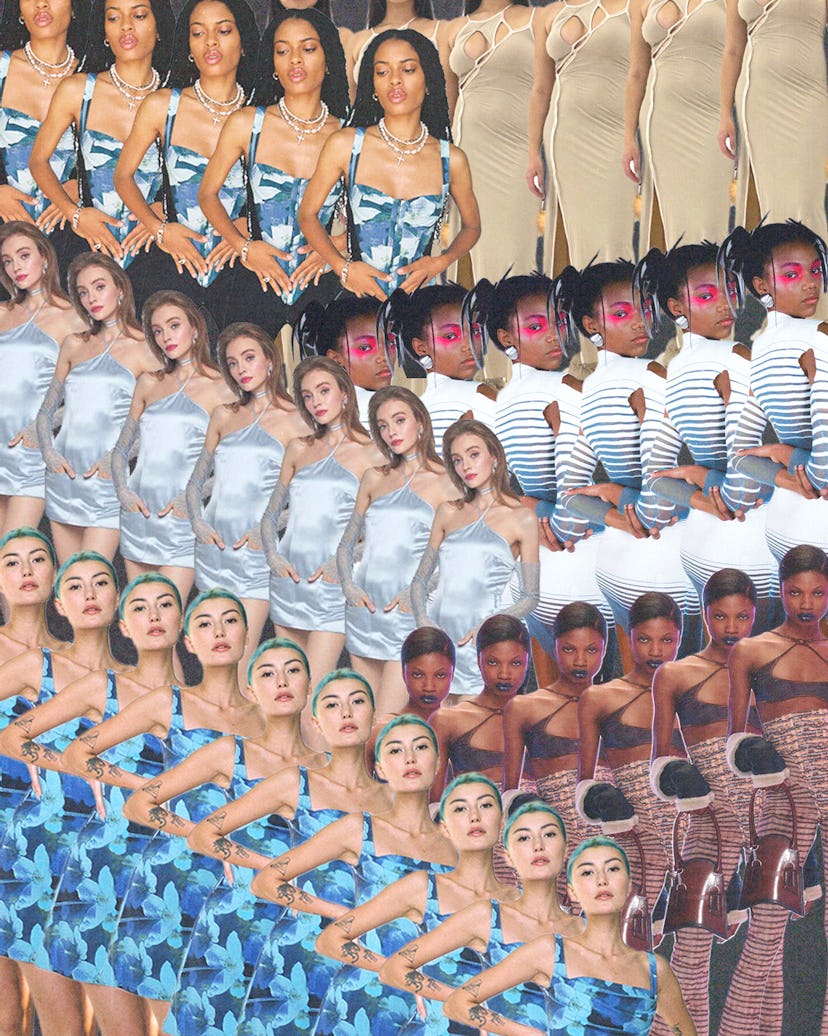Fashion Is Welcoming a New Era of Bodycon

Proportions in fashion have become a little bit tighter and a lot shorter. A new form of bodycon that’s been trending for a few seasons may be reaching its peak in spring 2021: mesh pants from Charlotte Knowles’s brand KNWLS; strappy, tight dresses with cutouts from Ottolinger, and new knitted fabrics that mold to the body from Chet Lo are dominating the emerging fashion scene. Elsewhere, Mugler, Alaïa, and Givenchy are showing similar moods for fall 2021.
There are a number of cultural movements and happenings that explain this new trend, which takes after the bandage going-out dresses and skirts of the Nineties and early aughts—but with a twist. There is, of course, the pandemic: after more than a few seasons of boxy shapes, comfortable Crocs, and flowing fabrics, it only makes sense that the pendulum would swing in the opposite direction. “Fashion can often mark important transitions, both collective and personal,” explains the fashion historian Caroline Elenowitz-Hess. “Ath-leisure and caftans were comfortable and comforting during the pandemic, but as things open up again, it makes sense to reject these items that are reminiscent of such a traumatic period and go in a more body-hugging direction. Of course, many are still going to wear comfortable clothing, but after a global period of immense stress, it’s no wonder people want to get dressed up again and put their bodies on display.”
At the same time, miniskirts and sky-high heels are officially two of the biggest spring trends. Extreme heels were seen at Versace, Balenciaga, Moschino, Hermès, and Valentino, while miniskirts ruled at Vetements, Vivienne Westwood, Max Mara, and many more. It makes sense the miniskirt would return at this time; the garment has historically been associated with liberation—look at the counterculture movements of the 1960s. The miniskirt also came to represent the youthquake movement and second-wave feminism, as women’s societal roles dramatically shifted due to an upshot in women entering the workplace and universities during that decade.
Corsets, in particular, have sky-rocketed in popularity during the pandemic—surprisingly, right alongside sweatpants. It’s near impossible to scroll through fashion Instagram without seeing some reference to a Vivienne Westwood corset, and celebs ranging from Hadid to FKA Twigs have recently worn them. “We’re in a corset resurgence as we come back into the age of curves,” adds Miaou designer Alexia Elkaim. “We are seeing a wave of body positivity in the fashion industry and it’s reflected in these new silhouettes and inclusive models we are finally seeing on the runway.”
For some designers, the decision to show a new era of bodycon pieces is a personal one. Take, for example, Miaou, which Elkaim founded for the sole purpose of creating the perfect pair of body-hugging jeans. Miaou’s most recent collection comprises plenty of corsets, minis, and bodycon dresses favored by the likes of Bella Hadid and Paloma Elsesser. “Miaou is a liberation,” explains Elkaim. “Personally, I love my body—I love my curves, my imperfections and design with that in mind. I’ve always been one to show off my body and I feel proud of that. I want our customers to feel that same sense of pride and love for their bodies.”
Likewise, the emerging brand Nana Jacqueline has put silk bodycon pieces and miniskirts on the map for spring 2021. “We want our customers to be empowered in their bodies, to feel strong when being the focus, and to express their confidence and braveness under all circumstances,” says designer Jacqueline Zhang. “The whole collection is inspired by Betty Boop—the cartoon icon was closely associated with feminism for her brave and sexy profile, which is what Nana Jacqueline stands for.”
Notably, the 2021 version of bodycon takes its inspiration from underpinnings. Even the aforementioned designer Charlotte Knowles sells structured corsets with technical cutouts. “There’s this intimacy associated with underwear and those sorts of pieces,” Knowles told W last year. “It was this archaic idea of femininity and privacy and intimacy, and today, we like to question this idea of intimacy—what is femininity? How can we take it outside? How can we take the idea of underwear into something else and use the detail and the language, and turn it into other things? There are always really intricate parts to underwear as well: it’s almost utilitarian because it’s so functional; everything has a function, made for a reason in a really beautiful way.”
Body positivity becoming more mainstream is a repeating refrain when it comes to bodycon 2.0—although there’s admittedly much more work to be done by the fashion industry in that department. For spring, Versace had three plus-size models walk the runway, while Ferragamo, Fendi, and Christian Cowan also had representation. The tight Hervé Leger bodycon dresses of the early aughts have a very different meaning than the bodycon looks of Ottolinger, Charlotte Knowles and Miaou pieces in 2021—which can be seen across various body types. Says Chet Lo, of his spiked knitwear dresses that are designed for a snug fit, and can be worn across various sizes depending on the look one prefers: “It fits so many sizes, which is something that is really important to me. My goal as a designer is really to push the boundaries of what people can and want to wear.”